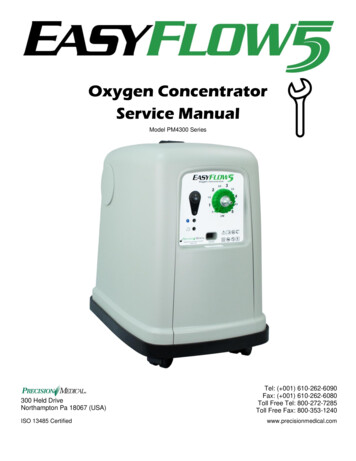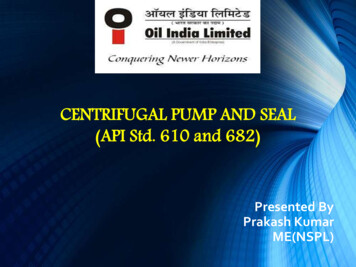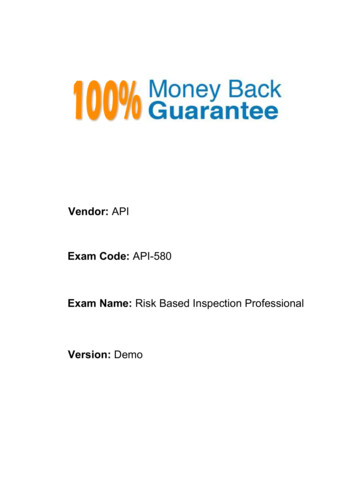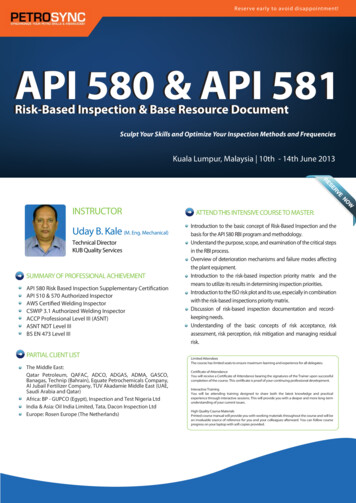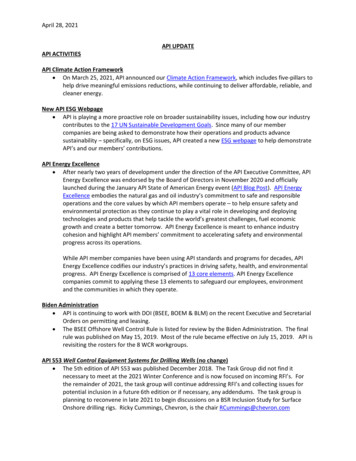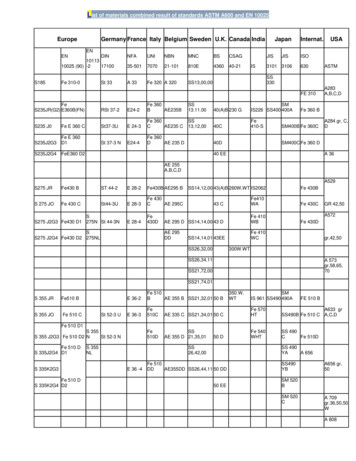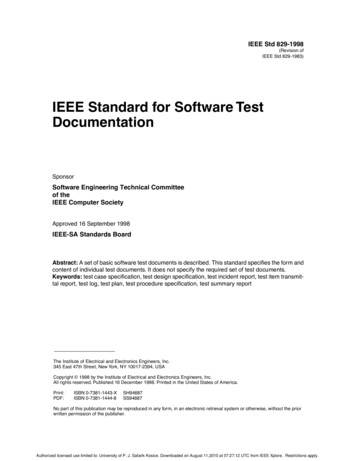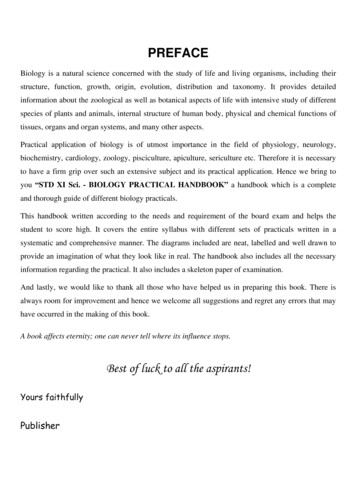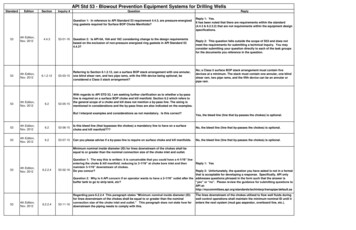
Transcription
API Std 53 - Blowout Prevention Equipment Systems for Drilling WellsStandardEditionSectionInquiry #QuestionQuestion 1: In reference to API Standard 53 requirement 4.4.3, are pressure-energizedring gaskets required for Surface BOP Choke Manifolds?534th Edition,Nov. 2012534th Edition,Nov. 2012534th Edition,Nov. on 2: Is API 6A, 16A and 16C considering change to the design requirementsbased on the exclusion of non-pressure energized ring gaskets in API Standard 534.4.3?Referring to Section 6.1.2.12, can a surface BOP stack arrangement with one annular,one blind shear ram, and two pipe rams, with the fifth device being optional, beconsidered a Class 5 stack arrangement?ReplyLast update: August 12, 2015Reply 1: Yes.It has been noted that there are requirements within the standard(4.4.3 & 6.2.2.2) that are not requirements within the equipment designspecifications.Reply 2: This question falls outside the scope of S53 and does notmeet the requirements for submitting a technical inquiry. You mayconsider submitting your question directly to each of the task groupsfor the documents you reference in the question.No; a Class 5 surface BOP stack arrangement must contain fivedevices at a minimum. The stack must contain one annular, one blindshear ram, two pipe rams, and the fifth device can be an annular orpipe ram.With regards to API STD 53, I am seeking further clarification as to whether a by-passline is required on a surface BOP choke and kill manifold. Section 6.2 which refers tothe general scope of a choke and kill does not mention a by-pass line. The sizing ismentioned in considerations and the by-pass lines are also indicated on the examples.But I interpret examples and considerations as not mandatory. Is this correct?Yes, the bleed line (line that by-passes the chokes) is optional.534th Edition,Nov. 20126.253-06-15Is this bleed line (that bypasses the chokes) a mandatory line to have on a surfacechoke and kill manifold?No, the bleed line (line that by-passes the chokes) is optional.534th Edition,Nov. 20126.253-07-15Can you please advise if a by-pass line is require on surface choke and kill manifolds.No, the bleed line (line that by-passes the chokes) is optional.Minimum nominal inside diameter (ID) for lines downstream of the chokes shall beequal to or greater than the nominal connection size of the choke inlet and outlet.534th Edition,Nov. 20126.2.2.453-02-16534th Edition,Nov. 20126.2.2.453-11-16Question 1: The way this is written; it is conceivable that you could have a 4-1/16” lineentering the choke & kill manifold; reducing to 3-1/16” at choke bore inlet and thenmaintain 3-1/16” downstream of chokes.Do you concur?Reply 1: YesReply 2: Unfortunately, the question you have asked is not in a formatthat is acceptable for developing a response. Specifically, API onlyQuestion 2: Why is it API concern if an operator wants to have a 2-1/16” outlet after the addresses questions phrased in the form such that the answer isbuffer tank to go to strip tank, etc?“yes” or “no”. Please review the guidance for submitting questions toAPI p/transpipe/default.aspxRegarding para 6.2.2.4 This paragraph states “Minimum nominal inside diameter (ID)The lines downstream of the chokes utilized to flow well fluids duringfor lines downstream of the chokes shall be equal to or greater than the nominalwell control operations shall maintain the minimum nominal ID until itconnection size of the choke inlet and outlet.” This paragraph does not state how far enters the next system (mud gas separator, overboard line, etc.).downstream the piping needs to comply with this.
Background: A drilling contractor has a well control system with BOPs, choke and killmanifolds rated at 10,000 psi. The equipment is being used on a 5000 psi well head.The choke manifold has one remote operated drilling choke.534th Edition,Nov. 20126.2.2.86.2.2.953-14-14Question 1: Referencing 6.2.2.8 and 6.2.2.9, is it correct that the equipment istechnically de rated to 5000 psi for the wellhead?Question 2: Is only one remote operated choke is required?534th Edition,Nov. 20126.2.3.2.253-02-14Referring to Section 6.2.3.2.2, can you please clarify further the meaning of the sizerange shown and your interpretation of nominal diameter?Reply 1: API 53 does not address de-rating. For the specific wellmentioned in this question, the equipment can only be tested to 5000psi (see 6.5.3.2.6).Reply 2: YesThe intent is that the pipe ID be as close as practical to the ID of thevalves.Background: When a piece of equipment is built to an API equipment specification itcomplies with the specification at the time it was built. If it is repaired orremanufactured, it may be brought up to the latest edition of the equipmentspecification if possible. Therefore, in service equipment on a rig may not comply withall of the requirements of the latest edition of the relevant equipment specification.This intepretation has been rendered invalid as a result of publication of APIS53, 4th Edition, Addendum 1 in July 2016. Therefore this interpretation hasbeen withdrawn as a result of these updated requirements.534th Edition,Nov. 20126.3.1.17.3.1.17.4.1.153-01-13API 53, Section 2 (Normative References), states “For undated references (no dateincluded in the listing), the latest edition of the referenced document applies”. Sections6.3.1.1, 7.3.1.1, and 7.4.1.1 state “Control systems for subsea BOP stacks shall bedesigned, manufactured, and installed in accordance with API 16D”. API 53 also statesin various sections that you shall meet API 16D, Method A, B, or C for prechargecalculations, which is calling out a specific requirement of API 16D.The intent is that compliance with the normative references applies atthe time the rig is built and/or the BOP system or components areinstalled. This can also be affected by a contractual agreement orregulatory requirements.Question: Do Sections 6.3.1.1, 7.3.1.1, and 7.4.1.1 require in-service control systems toalways be 100% in compliance with the latest API 16D, or are these sections referringonly to specific requirements of 16D like the precharge?53534th Edition,Nov. 20124th Edition,Nov. 20126.2.3.2.26.2.3.2.2.b53-09-1353-08-16Section 6.2.3.2.2 a) advises what the minimum nominal I.D. for choke lines by pressureNo; 4-inch up to, but not including 7 1/16-inch. bore equipment, is notrating only. For pressure rated systems 10K and above, is a 3 in. nominal I.D. choke lineaddressed in API 53 or API 16A.required for 4-inch. and 7-inch. through-bore BOP equipment?Section 7.2.2.11 states "The bleed line (if installed, the line that bypasses the chokes)shall be." Section 6.2.3.2.2.b states "The bleed line (the line that bypasses the chokes)shall be.". It does not contain the "if installed" language, but it is sub-headed underNo, the bleed line (line that by-passes the chokes) is optional6.2.3.2 Other Considerations for Choke Lines.(reference previous interpretations 53-05-15, 53-06-15 and 53-07-15).Is a bleed line to bypass the choke lines REQUIRED on choke manifold assemblies onsurface BOP installations?
534th Edition,Nov. 2012534th Edition,Nov. 20126.3.56.2.353-12-13Yes; the intent of 6.3.5.4 and 6.3.5.5 is to conduct the test at preIs API 53, Sections 6.3.5.4 and 6.3.5.5 saying that the pumps need to be checked on thedeployment, initial latch-up, and not-to-exceed six months. Any otherinitial test and the subsequent tests, only on the initial test, or only when the equipmenttesting is at the discretion of the equipment owner or other applicableowner’s PM program requires it?requirements that fall outside of API 53.53-12-14Referencing 6.2.3, there are some cases where we can't have a straight exit lines afterbuffer chamber at choke manifold because of the position or space to flare pits on therig's location. Following the recommendations that we have for choke and kill bends,can we use that for the choke manifold exit lines before buffer chamber?A drilling contractor has a new rig with a subsea MUX stack and subsea conventionalstack (for weight on older wellheads). They have stated that the drape hose are belowthe moonpool and that the shielding is more for wave motion than fire rating. Themoon pool conduit lines are hard pipe.See 6.4.11 for vent line recommendations.Keep in mind that API 16D is the specification for control systems; donot confuse the requirements of API 16D with those of API 16C (chokeand kill systems). Additionally, Section 6.3.11.2.5 applies only toSections 6.3.11.2.5, 7.3.13.2.5, 7.4.8.2.5, and 7.3.13.2.5 are ambiguous with respect to the surface BOP’s.requirement of fire retardant hoses. It is our understanding that the requirement in7.3.13.2.5 takes precedence and hence the hoses should not be fire retardant.The intent in API 53 is to provide a weak link between the controlsystem and the BOP because the fire retardant properties would beThe note in Std 53 indicates that the API requirement assumes that a fire in thecounter to the intended purpose of the emergency system. Since theremoonpool would burn out the conduit hoses and hence trigger the deadman system if are many vessel designs in operation it is not practical to have athe electrical signals are also lost. For our deepwater semis however, it is not likely that different option for each. Sections 7.3.18 and 7.3.19 require floatingthe hoses are affected by a fire in the moonpool as the hoses are hanging below bottom rigs to have an autoshear and deadman respectively, therefore shouldbox of the rig. There is no requirement in the API of how short time the hose shouldbe interpreted as: “Rigid conduit and hot line supply hoses betweensustain a fire, and hence the design will not be a proper form of weak link design.the control system and the BOP shall NOT be fire retardant”.Can you clarify if a fire retarded hose for the conduit line and hot line will fulfil therequirements in Std 53?This intepretation has been rendered invalid as a result of publication of APIS53, 4th Edition, Addendum 1 in July 2016. Therefore this interpretation hasbeen withdrawn as a result of these updated requirements and replaced withthe following interpretation.534th Edition,Nov. 3
A drilling contractor has a new rig with a subsea MUX stack and subsea conventionalstack (for weight on older wellheads). They have stated that the drape hose are belowthe moonpool and that the shielding is more for wave motion than fire rating. Themoon pool conduit lines are hard pipe.534th Edition,Nov. 3Section 6.3.11.2.5 applies only to surface BOP’s.Sections 6.3.11.2.5, 7.3.13.2.5, 7.4.8.2.5, and 7.3.13.2.5 are ambiguous with respect to therequirement of fire retardant hoses. It is our understanding that the requirement inAPI 53 is making the fire retardant requirement of API 16D not required7.3.13.2.5 takes precedence and hence the hoses should not be fire retardant.for the control lines and hot line supply between the control systemand BOP. The intent is to provide a weak link between the controlThe note in Std 53 indicates that the API requirement assumes that a fire in thesystem and the BOP because the fire retardant properties would bemoonpool would burn out the conduit hoses and hence trigger the deadman system if counter to the intended purpose of the emergency system. Since therethe electrical signals are also lost. For our deepwater semis however, it is not likely that are many vessel designs in operation it is not practical to have athe hoses are affected by a fire in the moonpool as the hoses are hanging below bottom different option for each.box of the rig. There is no requirement in the API of how short time the hose shouldsustain a fire, and hence the design will not be a proper form of weak link design.Can you clarify if a fire retarded hose for the conduit line and hot line will fulfil therequirements in Std 53?This intepretation has been rendered invalid as a result of publication ofAPI S53, 4th Edition, Addendum 1 in July 2016. Therefore this interpretationhas been superceded as a result of these updated requirements and replaced5353534th Edition,Nov. 20124th Edition,Nov. 20124th Edition,Nov. 20126.3.86.3.86.5.2.2.153-16-14In reference to 6.3.8 on response time and 7.6.5.1.1 on function tests, if a systemincludes a high pressure shear circuit (used for emergencies) and a regulated shearcircuit, which circuit should be used to determine if closing times are met, the highpressure shear circuit that would be used in a well control event, or, the regulatedcircuit with lower pressure?Response times shall be met by at least one of the surface/subseapower circuits. See 6.3.8.4, 7.3.10.4, and 7.4.6.5.4.53-16-14In reference to 6.3.8 on response time and 7.6.5.1.1 on function tests, if a systemincludes a high pressure shear circuit (used for emergencies) and a regulated shearcircuit, which circuit should be used to determine if closing times are met, the highpressure shear circuit that would be used in a well control event, or, the regulatedcircuit with lower pressure?Response times shall be met by at least one of the surface/subseafluid supplies. See 6.3.8.4, 7.3.10.4, and 7.4.6.5.4.53-03-16On page 33 of the standard under 6.5.2.2.1 is stated "Inspection practices andprocedures vary and are outside the scope of this document."Question 1: Does API have a document that states the frequency of inspectionsperformed?Reply 1: Yes, API Standard 53 discusses frequency of inspections, butnot the practices and procedures. For surface BOP systems seeSection 6.5.7.Question 2: Or a document that goes in depth as to what level of service is required forReply 2: No.Onshore BOPs?
534th Edition,Nov. 20126.5.353-01-14Referring to Table 2 and Table 3 in 6.5.3, do the terms "upstream and downstream"mean that the pressure test must be carried out in both di
12.08.2015 · API 53, Section 2 (Normative References), states “For undated references (no date included in the listing), the latest edition of the referenced document applies”. Sections 6.3.1.1, 7.3.1.1, and 7.4.1.1 state “Control systems for subsea BOP stacks shall be designed, manufactured, and installed in accordance with API 16D”. API 53 also states


![API Ballot: [Ballot ID] – API 510 & API 570, Deferrals, Rev05](/img/5/api510andapi570deferralsrev5.jpg)
